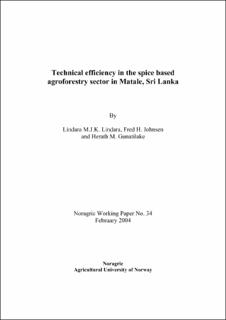Technical efficiency in the spice based agroforestry sector in Matale, Sri Lanka
Abstract
Spices constitute an important sub-sector of the economy of Sri Lanka. Most perennial spices are cultivated in agroforestry types of farming systems. The technical efficiency of spice based agroforestry systems was estimated in order to identify the potential increase in production without incurring additional costs for farm inputs. The factors affecting technical efficiency and constraints and potential of the agroforestry system were also investigated. A field survey was conducted covering 120 agroforestry farmers in six divisional secretariats in Matale district during the period of October to December 2002. According to a stochastic frontier production function using a Cobb-Douglas model, hired labour, organic fertilizer, inorganic fertilizer, land size, and soil fertility maintenance cost showed significant positive effects on the agroforestry production. The mean technical efficiency of the spice based agroforestry systems was 84.32 percent. According to the inefficiency model the efficiency increased significantly as a result of farm visits by extension officers, participation in farmer training, less sloping lands, more experience, and higher diversity of the agroforestry system. Technical efficiency decreased, however, with higher education level of the farmer and with higher off-farm income. Farm income from the spice based agroforestry system is low due to low productivity, market constraints, lack of technology, and institutionally related constraints. Environmental conditions in Sri Lanka are such that a vast number of high value export crops can be grown in the agroforestry system. There is a good possibility for stepping up production of these crops in marginal lands through appropriate crop diversification.
